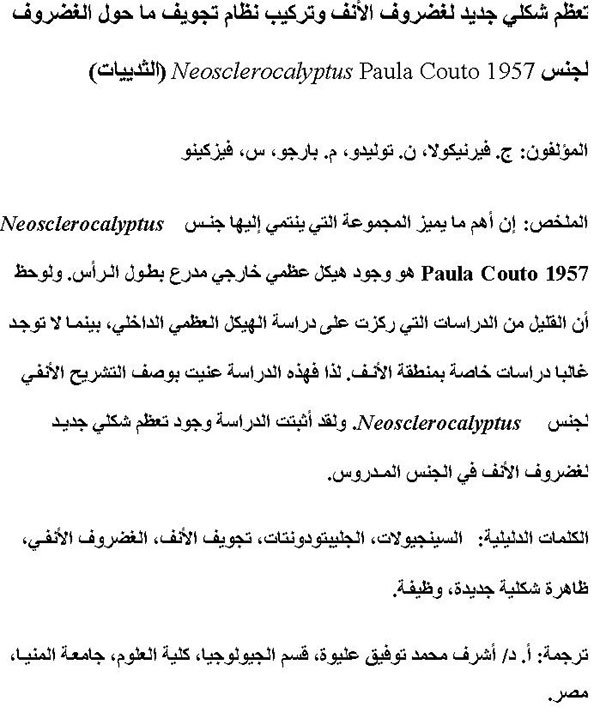A neomorphic ossification of the nasal cartilages and the structure of paranasal sinus system of the glyptodont Neosclerocalyptus Paula Couto 1957 (Mammalia, Xenarthra)
Plain Language Abstract
Glyptodonts are extinct animals belonging to the group of xenarthrans, South American placental mammals also comprising sloths, anteaters and armadillos. The group containing both armadillos and glyptodonts is known as Cingulata, and members of this group have a characteristic bony armor protecting their head, trunk and tail. Among Pleistocene (~ 2.5 Ma) glyptodonts the skull of Neosclerocalyptus is very remarkable due to its bizarre, globular and expanded narial region. In this work we analyzed external and internal anatomy of the skull of Neosclerocalyptus using computed tomography (CT) scanning. We found that the most anterior portion of the narial region is formed by ossification of the nasal cartilages, a feature absent in other mammals and that probably represents a shift in the timing of developmental stages when compared with other cingulates (a phenomenon called “heterochrony”). This neomorphic ossification housed very well developed respiratory turbinates, folded bony structures that warm and humidify the air entering to the nasal cavity during breathing. The other bones of the skull roof (nasals, frontals and parietals) have an expanded system of interconnected inner cavities, called paranasal sinuses. The function of these cavities remains enigmatic. Finally, at the bottom of the nasal cavity there were, as in other mammals, olfactory turbinates (called “ethmoturbinates”), widely separated from the respiratory ones. The nasal cavity as a whole, comprising ossified nasal cartilages and turbinates, probably had similar functions to those of other mammal. Thus, this neomorphic ossification would constitute a morphological novelty, but not necessarily a functional one.
Resumen en Español
Una osificación neomórfica de los cartílagos nasales y la estructura del sistema de senos paranasales del gliptodonte Neosclerocalyptus Paula Couto 1957 (Mammalia, Xenarthra)
Los gliptodontes, junto con los armadillos, los pampatéridos y los peltefilinos constituyen los Cingulata, uno de los tres clados de los Xenarthra. La característica más notable de este grupo es la presencia de un exoesqueleto acorazado a lo largo de la cabeza, el cuerpo y la cola. Sólo unas pocas contribuciones han descripto el endosqueleto en detalle. En el caso del cráneo, apenas se ha prestado atención a la región nasal. El objetivo de este artículo es proporcionar una descripción de la región nasal del gliptodonte Neosclerocalyptus. Este género tiene la región nasal más expandida y globular entre los gliptodontes, habiendo sido descrita recientemente como parte del sistema de senos fronto-nasales. Nuestro análisis mediante tomografía computarizada muestra que esta región incluye una osificación independiente del cartílago nasal que albergaba los maxilo-atrioturbinales. Esta osificación representaría un carácter neomórfico producido por una adición terminal de un estadio osificado mediante peramorfosis. Otras características anatómicas destacadas son la presencia de un sistema expandido de senos paranasales que involucra a los huesos nasal, frontal, parietal y escamosal, y la amplia separación entre los maxilo-atrioturbinales y los etmoturbinales. Las consecuencias funcionales de esta reorganización son difíciles de predecir o inferir. Por tanto, dicha osificación neomórfica constituiría una novedad morfológica, aunque no necesariamente funcional.
Palabras clave: Cingulados; gliptodontes; cavidad nasal; osificación nasal; neomórfico; función
Traducción: Author and Miguel Company
Résumé en Français
Une ossification néomorphique du cartilage nasal et la structure du système de sinus paranasale chez le glyptodonte Neosclerocalyptus Paula Couto 1957 (Mammalia, Xenarthra)
Les glyphodontes, de même que les tatous, pampathères et peltephilinés constituent les Cingulata, l'un des trois clades de Xenarthra. Le caractère le plus remarquable de ce groupe est la présence d'une armure exo-squelettique le long de tête, du corps et de la queue. Très peu de contributions ont décrit en détail l'endosquelette. Dans le cas du crâne, presque aucune attention n'a été portée à la région des cavités nasales. L'objectif de cette étude est de fournir une description de l'anatomie des narines du glyphodonte Neosclerocalyptus. Ce genre a les narines les plus étendues et les plus globulaires parmi les glyphodontes et a été récemment décrit comme part du système de sinus fronto-nasaux. Notre analyse au CT-scan montre que cette région inclus une ossification indépendante du cartilage nasal qui loge les maxillo-atrioturbinates. Cette ossification pourrait représenter un caractère néomorphique produit par l'ajout final d'un stade d'ossification par péramorphose. D'autres caractères anatomiques remarquables sont la présence d'un système de sinus paranasal étendu qui inclue les os nasal, frontal, parietal et squamosal, et la large séparation entre les maxillo-atrioturbinates et les ethmoturbinates. Les conséquences fonctionnelles de ce réarrangement ne sont pas facilement prédictibles ou déductibles. Donc, cette ossification néomorphique pourrait constituer une innovation morphologique, mais pas nécessairement une innovation fonctionnelle.
Mots clés : Cingulates; Glyptodontes; cavité nasale; ossification des narines; néomorphique; fonctionnement
Translator: Olivier Maridet
Deutsche Zusammenfassung
Eine neomorphe Ossifikation des Nasenknorpel und die Struktur des paranasalen Sinus-Systems des Glyptodonten Neosclerocalyptus Paula Couto 1957 (Mammalia, Xenarthra)
Glyptodonten bilden zusammen mit den Gürteltieren, Pampatheren und Peltephilinen die Cingulata, einer der drei Kladen der Xenarthra. Das auffälligste Merkmal dieser Gruppe ist das gepanzerte Exoskelett am Kopf, Körper und Schwanz. Nur einige wenige Arbeiten befassten sich im Detail mit dem Endoskelett. Beim Schädel wurde der Nasenregion kaum Aufmerksamkeit gewidmet. Das Ziel dieser Studie ist es, eine Beschreibung der Nasenanatomie des Glyptodonten Neosclerocalyptus anzufertigen. Diese Gattung hat die weiteste und kugelförmigste Nasenregion unter den Glyptodonten und war kürzlich als Teil der Fronto-Nasal Sinussysteme beschrieben worden. Unsere auf Computertomographie beruhende Analyse zeigt, dass diese Region eine eigene Nasenknorpel-Ossifikation beinhaltet, die die Maxillo-Atrio-Nasenmuscheln beherbergt. Diese Verknöcherung würde ein neomorphes Merkmal darstellen, das durch eine terminale Ergänzung einer verknöcherten Phase über Peramorphose hervorgerufen wurde. Weitere bemerkenswerte anatomische Merkmale sind das Vorhandensein eines erweiterten paranasalen Sinussystems das das Nasal, Frontale, Parietale und Squamosum umfasst und die breite Trennung zwischen den Maxillo-Atrio-Nasenmuscheln und den ethmoidalen Nasenmuscheln. Die funktionalen Konsequenzen dieser Anordnung sind noch nicht bekannt oder erschlossen. So könnte diese neomorphe Ossifikation zwar ein morhphologisches, jedoch nicht zwingend ein funktionales Novum darstellen.
Schlüsselwörter: Cingulata; Glyptodonten; Nasenkavität; Nariale Verknöcherung; Neomorph; Funktion
Translators: Eva Gebauer
Arabic

Translator: Ashraf M.T. Elewa

